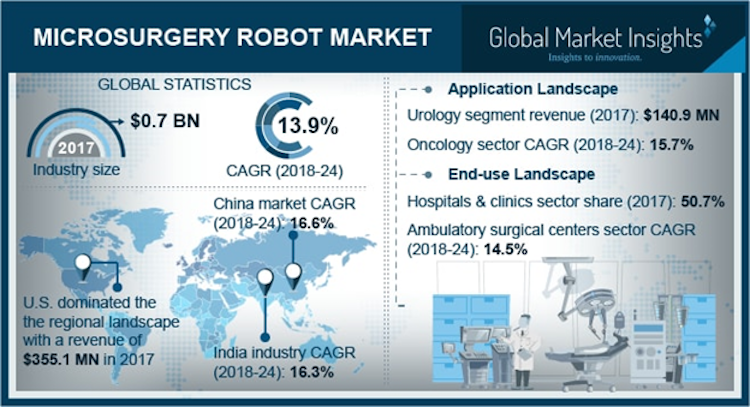Microsurgery robot market to play ‘key role’ in advanced cardiovascular diseases and cancer treatments
The microsurgery robot market is predicted to play “key role” in advanced coronavirus and cancer treatments, according to research by Global Market Insights.
The US microsurgery robot market accounted for $355.1 million in 2017, owing to increasing incidence of cardiovascular, neurovascular, oncology and other chronic diseases.
The increasing prevalence of chronic disease will favor industry growth in the region. Favorable healthcare and reimbursement policies coupled with adoption of technologically advanced microsurgery robots will promote revenue generation in the future.
Germany’s microsurgery robot market will witness a strong growth rate of 15.3 percent during the projected timeframe. The high growth rate is credited to initiatives taken by the European Union for promoting usage of advanced technologies including robot-assisted microsurgery for healthcare purposes.
For instance, European Association of Urology has launched the Robotic Urology Section. This will lead to a high adoption rate of microsurgery robots in urology, thereby favoring business growth throughout the forecast timeline, according to GMI.

Robotic microsurgery is gaining significant importance in a growing range of surgical specialties. Robotic technologies have immense potential to improve the overall capacity and efficiency of healthcare systems.
Microsurgery robots can help healthcare professionals improve the quality of surgical procedures. In addition, surgical robots can minimize the hospitalization time for patients and reduce the impact of surgery on their post-operative life.
Advancements in Microsurgery robots are anticipated to drive future innovations in surgical technologies and will play a critical role in addressing some of the major operating challenges.
Surgical robots in use today are more user-friendly and can perform highly delicate microsurgeries more accurately. This can be attributed to robust technological developments in optical technology that have enabled safe and effective intra-operative imaging.
The introduction of novel robot-assisted surgery technologies has enabled the early detection, diagnosis, and treatment of various health conditions. Global Market Insights, predicts that global microsurgery robot market size will be worth more than $1.7 billion by 2024.
Strong demand for cardiovascular surgeries
The rising prevalence of cardiovascular diseases around the world is expected to be a major propellant of microsurgery robot market technology.
According to the World Health Organization (WHO), cardiovascular diseases, particularly heart attacks and stroke, result in nearly 17 million deaths each year. Studies also show that the incidence and risk of strokes increase with age, in both men and women.
This trend will certainly boost the demand for robotic cardiac surgery which has completely revolutionized the way various heart operations are being performed.
The technology enables surgeons to perform complex cardiovascular surgeries with precise motion control and smaller incisions, providing patients with better results.
The most important benefit that robotic cardiac surgery offers is that the procedure is minimally-invasive compared to open-heart surgery. In addition, smaller incisions mean that patients can heal much faster and resume daily activities more quickly.
The widespread usage of microsurgery robots has further drawn the attention of prominent industry players to bring innovation and technological advancements to strengthen their stance in the expanding microsurgery robot market.
Rising cancer burden across the globe
The WHO reports that cancer, which accounted for around 9.6 million fatalities across the globe during 2018, is the second major cause of death. The rising cancer burden can be attributed mainly to several factors such as robust population growth and aging along with the growing prevalence of certain social and economic conditions.
This trend has been particularly observed in emerging economies. There has been a major shift from cancers caused due to poverty and infections to cancers associated with lifestyle changes, substantially in countries witnessing industrialization.
Over the past few years, robotic microsurgery has gradually become a new standard of treatment for cancers such as gynecological, prostate and abdominal.
Microsurgery robots assist doctors and surgeons, enabling them to operate on various tumors more precisely and flexibly. Surgical robots give healthcare professionals more control during surgery compared to conventional techniques.
Growing application in neurovascular surgeries
Neurovascular disorders are being increasingly recognized as major causes of death and disability worldwide. Neurological disorders span Alzheimer’s and other dementias, migraine and other headache disorders, cerebrovascular diseases such as stroke, Parkinson’s diseases, multiple sclerosis, brain tumors, and a range of neuroinfectious disorders.
Citing statistical records, there were about 47.5 million people suffering from dementia globally in 2016, with around 7.7 million new cases registered each year. Alzheimer’s disease, which accounts for around 60-70 percent of cases, is known to be the most common cause of dementia.
The growing occurrence of neurological disorders should fuel the demand for robot-assisted neurosurgery. It offers numerous benefits to patients including shorter hospitalization, reduced blood loss, lower risk of transfusions, and reduced pain and comfort.
Many healthcare professionals are increasingly relying on robotics for neurosurgical procedures.
For instance, in November 2019, a group of doctors from Toronto, Canada successfully completed the world’s first brain aneurysm surgery with the help of robotic surgical assistants.
This indicates the potential of Microsurgery robots market in the treatment of different neurovascular health conditions, especially in regions lacking specialized surgical expertise.
Investment in research and development and the introduction of newer, more innovative products has been a key strategy adopted by industry participants.
Citing an instance, Dublin, Ireland-headquartered medical devices company Medtronic in September 2019 unveiled a new RAS platform, the Hugo system, which it claims is more cost-effective and flexible than systems presently on the market. The company plans to launch the platform in select places outside the US sometime this year.
Prominent industries involved in microsurgery robot market are Auris Health, Intuitive Surgical, Mazor Robotics, Medrobotics, Medtronic, Smith & Nephew, Stryker, Titan medical, Transenterix and Zimmer Biomet
Technological innovations promise an incredibly exciting future for Microsurgery robots.
Advanced robotics will result in significant cost reductions and the implementation of the latest technologies such as tactile and haptic sensing and force feedback technology may also help solve some of the major drawbacks of robotic microsurgery in the forthcoming years.

